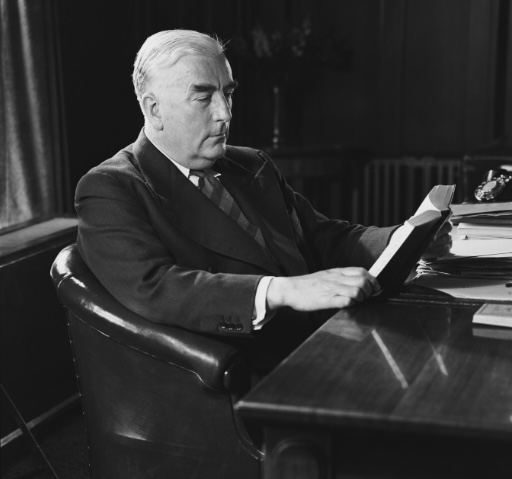On this day, 13 February 1954, Australian Antarctic Division Director Phillip Law raises the Australian flag to establish Mawson Station, which has since become the longest continuously operating research station south of the Antarctic Circle. An initiative of the Menzies Government, the aim of the station was two-fold: firstly to act as a base for scientific research, and secondly to make tangible Australia’s claim to 42% of the frozen continent with a permanently occupied base.
The outpost was to be aptly named after Sir Douglas Mawson, the Australian icon who had made a name for himself during the ‘Heroic Age’ of Antarctic exploration and who has since been immortalised on the original Australian $100 note. Mawson had been involved in several notable polar expeditions, and had seen friends lose their lives in the name of furthering scientific knowledge (indeed he was lucky that he himself did not meet this fate). In 1930 he would return as head of the British, Australian and New Zealand Antarctic Research Expedition, to make Australia’s official claim to its Antarctic territory. However, such claims were and are highly contested in international law, and so it was a significant act to establish a permanent base to make physical Australia’s occupation. To this day only four countries – France, Norway, New Zealand, and Britain – recognise Australia’s massive polar territory as clearly belonging to it.
The relevant Menzies Minister Richard Casey (who was responsible for both External Affairs and the CSIRO) had long been interested in Antarctic matters, having been Chairman of the Polar Committee of the Imperial Conference as far back as 1937. In announcing the new expedition to Parliament, he explained the purposes of the permanent base:
‘The Australian Antarctic Sector is of vital importance to Australia. For strategic reasons it is important that this area, lying as it does so close to Australia’s back door, shall remain under Australian control. Meteorologically the region is of great value, for weather forecasts in Australia’s southern States can be improved by the collection of meteorological data from this region. In such a vast area there must be great mineral wealth – in fact huge deposits of coal have already been found and many valuable and useful minerals are known to exist. The possibility of finding uranium in this region must be borne in mind because of the geological similarity between parts of Australia’s Antarctic Territory and those parts of southern Australia where uranium has been found. In the future it is possible that aircraft flying between South America or South Africa and Australia will take the short route over the Antarctic Continent. The Antarctic is of the greatest interest to scientists, and specialists in many fields of research are anxious to receive results from this desolate and uninhabited region. Great food resources in the form of whales, fish, seals, birds and plankton are awaiting exploitation in the prolific seas which surround Antarctica and the world may soon be forced to turn to this source of supply as a consequence of the continual worsening of the world food position. In short, we cannot afford to neglect this important region, for no one can predict what importance it may assume in the next fifty years.’
Ultimately, an arms race for the resources of the southernmost continent thus foreshadowed would be avoided with the passing of the 1959 Antarctic Treaty which essentially established a truce over claims to the territory, and insisted on three points:
- Antarctica shall be used for peaceful purposes only – it was to be a demilitarised zone where nuclear weapons were banned.
- Freedom of scientific investigation in Antarctica and cooperation toward that end… shall continue
- Scientific observations and results from Antarctica shall be exchanged and made freely available
The Menzies Government was one of 12 initial signatories to the treaty, and Casey is said to have played a vital role in convincing the Soviet Union to sign up, making it clear to the Russians that a neutral Antarctica was as much in their interests as it was in the interests of the West. He even visited the Polar Institute at Leningrad to make the case personally to Soviet officials.
The treaty now involves 54 nations and continues to uphold that Antarctica’s primary purpose is scientific research and cooperation rather than economic exploitation and rivalry. Mawson Station has been at the forefront of this research for almost 70 years, exploring such vital areas as cosmic rays, space and atmospheric physics, studies in space weather, geophysics, glaciology, ecology of seabirds and marine mammals, meteorology and polar medicine.
For his foresight in establishing the base, Menzies would be rewarded by having ‘Mount Menzies’, the culminating peak on the large massif between Mount Mather and Mount Bayliss in Antarctica, named after him. Likewise, Richard Casey has been recognised with his own Antarctic Research Station, first established in 1969.
Further Reading:
Christy Collis, ‘Mawson and Mirnyy Stations: the spatiality of the Australian Antarctic Territory, 1954–61’. Australian Geographer, 2007.
Christy Collis, ‘Critical legal geographies of possession : Antarctica and the International Geophysical Year 1957–1958’, GeoJournal, 2010.
Tony Press, ‘Robert Menzies, Australia and the Antarctic Treaty’, The Strategist, Robert Menzies, Australia and the Antarctic Treaty | The Strategist (aspistrategist.org.au)
Sign up to our newsletter
Sign up for our monthly newsletter to hear the latest news and receive information about upcoming events.


